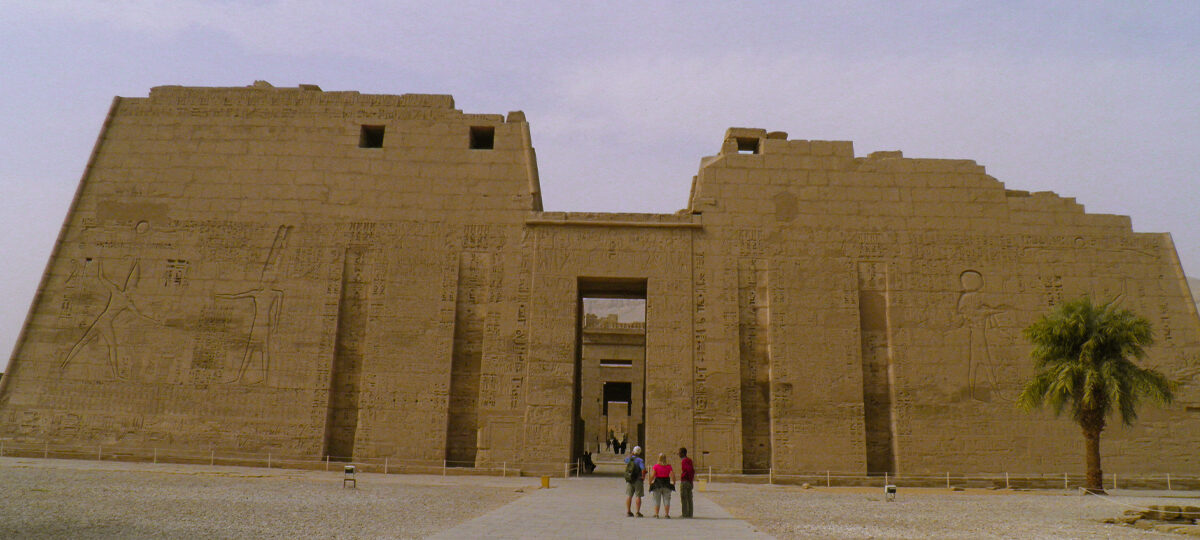Medinet Habu
The beautiful Medinat Habu Temple is one of the least visited places in Thebes, even though it is only second to Karnak in size and complexity. The centrepiece of the whole complex is the huge tomb temple of Ramses III, which looks like the Ramesseum of Ramses IP Medinet Location of the tomb of Ramses III, which is now called Habu. Ramses III was Pharaoh of Egypt for 31 years
(approximately 1183-1153 B.C.). The city’s real name is Habu, but the word “medinet” means “city.” Because of this, the area is called “Habu City.” The temple is built on a straight line, but its many entrances weren’t always set up in this way. In the past, there would have been a roof over the whole temple.

Temple of Medina Habu.
This sacred site is on a hill, south of the temples of Vizier Ay and Horemheb. Hatshepsut and Thutmosis III had already chosen this spot to build a small temple to the god Amun in two of his most important forms. This hill is thought to be one of the first places where creation happened (it is stated that the members of the Ogdoad were buried there).

Ramesses III’s Temple.

The architect Amenmose started building the temple in the fifth year of Rameses III’s rule. It is about 7,000 square metres in size and was started in that year. We are standing in front of a huge, heavily guarded temple that has a smaller palace that the pharaoh used as a temporary home. Rameses III had so much respect for his grandfather, Rameses II, that he built a chapel of devotion in his temple, next to the treasure chambers and the hypostyle room, to honour him. The last sanctuary, which is dedicated to Amon, is reached by walking through a series of walled enclosures.
Visit to the tomb of Ramesses III.
During later invasions of Egypt in the 20th Dynasty, everyone who lived in Thebes hid inside the temple’s huge walls.
On the pylons and walls of the temple, you can read about all of Ramses Ill’s military campaigns. In the second court, the colourful reliefs that show religious festivals are mostly still there. This is because the space was turned into a church by early Christians, who covered the pictures they found offensive with plaster.
West of the first court, you can find the ruins of Ramses I’s palace. Hatshepsut built the larger Temple of Mut. Tuthmosis III added to it and changed it, but it was still used until the Roman era. [Come with us to Luxor on one of our day trips!]
Visit the most popular outdoor museum. Anywhere on the first pylon of the temple and one of the many pictures of battles, parades, celebrations, and rituals inside the building. Some of the pictures are very dramatic, like those of charging chariots, fully armed armies, naval battles, prisoners with the name of the pharaoh written on them, or scribes counting mountains of severed hands and penises to figure out how many of the enemy’s soldiers were killed.

Ramses the Third was the second ruler of the 20th dynasty of the New Egyptian Empire (reigning from 1195 to 1164 B.C.). After Queen Twosret died, his commander father Setnakhte ruled for four years and then made his son the new king. During his record-breaking reign of 31 years and 49 days, Ramesses III married and had ten sons with his two main queens, Isis Ta Hemdjeret and Queen X. However, three of his sons gave up the throne after their father. During her rule, many different groups attacked Egypt, workers at Deir el-Medina who were building tombs in the Theban necropolis went on strike, and the king was killed.
Ramses III ordered the building of his tomb temple at Medinet Habu on the day he became king at Karnak.
Ramesses III fought two defensive battles against the Libyans and one against the so-called People of the Sea [learn more about the Battle of the Delta in 1175 BC]. The Medinet Habu tells about many things that happened during these three successful wars. Salvador Costa remembers that Ramses III’s wars were just defensive, even though he tried to make them look like Seti I or Ramesses II’s imperial expansion campaigns. He adds, “Some of the battles we see are real and some aren’t.”
The point of these and other pictures was to show that the pharaoh was the protector of cosmic order (Maat) who kept the country safe from chaos and danger. From the scenes at Medinet Habu, historians can learn a lot about how the war was fought at the time and who Egypt’s enemies were.
It’s one of the few buildings from ancient Egypt that still stands today, and because of how well the colours have been kept, you can still see works of art from the Pharaonic period.

